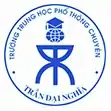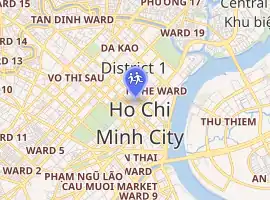Trần Đại Nghĩa High School For The Gifted
Tran Dai Nghia High School for the Gifted is an academically selective public school for talented and gifted students from grade 6 to 12 in Ho Chi Minh City, Vietnam. Established in 2000, Tran Dai Nghia High School for the Gifted was the first partially state-funded, semi-boarding school specializing in various subjects, especially in foreign languages in Ho Chi Minh city. The school requires entrance exams for admission (with less than 10% acceptance rate).[2]
| Tran Dai Nghia High School for the Gifted Trường THPT Chuyên Trần Đại Nghĩa | |
|---|---|
 | |
| Address | |
 | |
Gate 1: 20 Ly Tu Trong, Ben Nghe ward, District 1 Gate 2: 53 Nguyen Du, Ben Nghe Ward, District 1 | |
| Coordinates | 10.779609°N 106.700868°E |
| Information | |
| School type | Public, high school, Secondary school |
| Opened | 2000 |
| Principal | Nguyễn Minh |
| Staff | 214 [1] |
| Teaching staff | 168 |
| Grades | 10-12 |
| Song | Tran Dai Nghia March |
| Website | http://trandainghia.edu.vn/ |
School establishment
Founded in 2000, the school was named after Professor Trần Đại Nghĩa, a scientist and weapon engineer who invented the Vietnamese bazooka and SKZ recoilless rifle during the Vietnam War.[3] The school was set up by repurposing existing facilities of the Lasantaberd Institute, which was established in 1877. It was the first school to have Intensive English program in Hồ Chí Minh City. 2003 marked the school's first graduating class.
School facilities
The school has many academic facilities, including a library, 2 computer labs, an audiovisual room and a multimedia room. The school also contains one dining hall, a canteen and rooms for students to rest between classes. The school also has two basketball courts, three badminton courts as well as a volleyball court. In addition there are some basketball half-courts for students to practice inside the school ground. There are 6 blocks in the school: the main block in the center for the school managing board; 5 A, B, C, D, E blocks for classrooms. Additionally, block E is also used as a dining hall. As the number of students has been increasing every year, the number of classrooms and teachers has also risen.
In 2015, the school opened a second branch in District 2 for students from grades 6–7. With this, the entrance exam now accepts 525-600 students per year instead of the previous 300-400. This new branch includes 1 computer lab, a canteen, multiple sleeping quarters, and two dining halls. 2 out of 4 vice-principals are now working at branch 2. Due to the second branch being in District 2, an area far away from central Sai Gon, there is a shuttle service to help transfer students between the 2 schools.
Library
In 2019, the school opened a free library for all students to access. Working time: Monday-Friday: 8am-4pm, Saturday : 8am-12pm
Learning method and students' opportunities
Tran Dai Nghia High School's students are known to have high level of fluency in English, and the school has a reputation for being one of the best education institutions for foreign languages in Ho Chi Minh City.[4] Aside from English, high school students majoring in social subjects are also taught French, Korean, Chinese, Japanese or German as a second foreign language. In addition, classes of grade 10, 11 and 12 are ranged in to specializing classes such as English majoring class, Math majoring class, Literature majoring class, Chemistry majoring class, Physics majoring class and Biology majoring class. There are also triple-subjected classes: Math-Chemistry-Physics and Math-Literature-English classes. A growing number of study abroad scholarships are won by students, a fact on which the school prides itself.[5][6]
Class schedule
The school is a semi-boarding one in which students stay from 7:00 am to 4:30 pm for grade 8-12. Grade 6-7 stay from 7:30 am to 3:45 pm.
Classes are broken into 4 periods for grade 6-9 students and 5 periods for the rest in the morning. In the afternoon, classes start at 1:15 and usually lasts until 4:30, with a break from 2:45 pm to 3:00 pm. On Saturday, students in selection teams gather to take extra classes on the subject they major. After that, they can go home or use the school's facilities.
Extracurricular sports classes are available from 4:30 to 5:00 pm. As these classes are taught in the school yard, students are prohibited from entering the school yard for safety reasons.
Extracurricular activities
Athletics
Basketball, badminton, volleyball, chess, football and martial arts classes are also carried out after school, which is widely popular to students who want to improve their physical and mental condition. Half-court basketball is also regularly played after school between students. Sports competitions are held twice a year.
Competitions
There are a lot of contests and competitions so that students of all sorts can participate.
- Singing contests (both in Vietnamese and foreign languages)
- National teachers’ day celebration
- Science fairs
- Spring festival
- Sports competitions
- Well-bred students
- Creativity Contest
Clubs
- Journalism Club
- Handmade Club
- Photography Club (Specture)
- Art Club
- German Culture Club
- French Culture Club
- Blue Fire Club
- Papersane Book Club
- Japanese Culture Club
- American Culture Club
- Vietnamese Culture Club
- Korean Club
- Drama Club
- English Club
- Music Club
- Community Club
- Chinese Culture Club
- Physics Club
- Public Speaking & Debate Club
- Environment Club
- Model UN Club
- The Mersy Act
- Career Venture TDN
- NGOT LAB Baking Project
School Publications
Tran Dai Nghia High School releases an annual magazine titled "Nội san Trần Đại Nghĩa". Compiled by the journalism club and Vietnamese Literature teachers, the magazine includes selective writings and artworks by teachers and students.
The school also publishes a school photo book, called "kỷ yếu". Its contents is similar to the yearbook, but it is published perennially instead of annually.
An active student-run photoblog, called "Humans of TDN", can be found on Tumblr and Facebook. Mimicking the "Humans of New York", it publishes portraits and interviews of the school's staff and students.
References
- http://trandainghia.edu.vn/Thong-Tin/Chi-Tiet/75/Cong-khai-thong-tin-doi-ngu-nam-hoc-2013-2014.aspx
- Admin, Bởi. "Lịch sử hình thành và phát triển trường THPT Chuyên Trần Đại Nghĩa – TRƯỜNG THPT CHUYÊN TRẦN ĐẠI NGHĨA" (in Vietnamese). Retrieved 2021-08-15.
- "September 13 in History". Viet Nam News. 2004-09-14. Retrieved 2007-06-10.
- "Giới thiệu sơ lược trường Trần Đại Nghĩa TPHCM - Trần Đại Nghĩa". Retrieved 2015-09-28.
- "Cựu học sinh Trần Đại Nghĩa giành học bổng gần 5 tỷ đồng - Trần Đại Nghĩa". Retrieved 2015-09-28.
- http://mothegioi.vn/. "Bí quyết săn học bổng du học của học sinh trường chuyên". Retrieved 2015-09-28.
{{cite web}}: External link in|last=